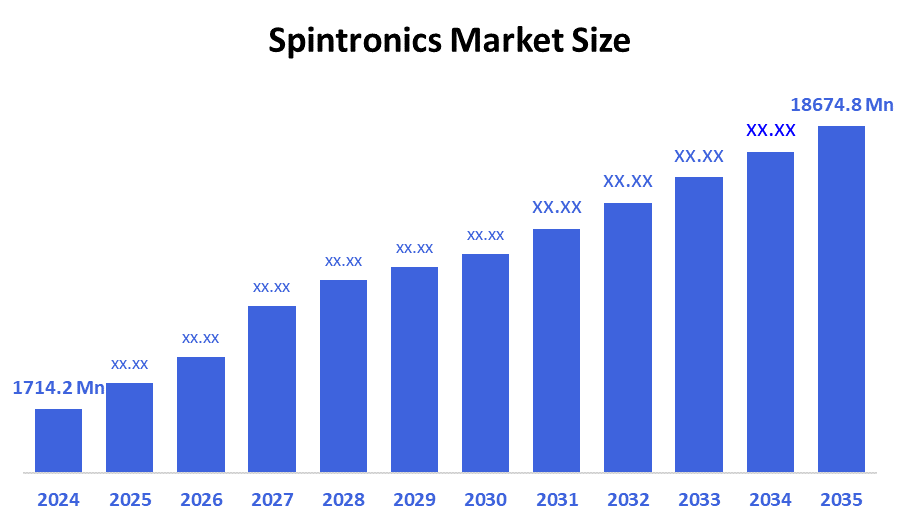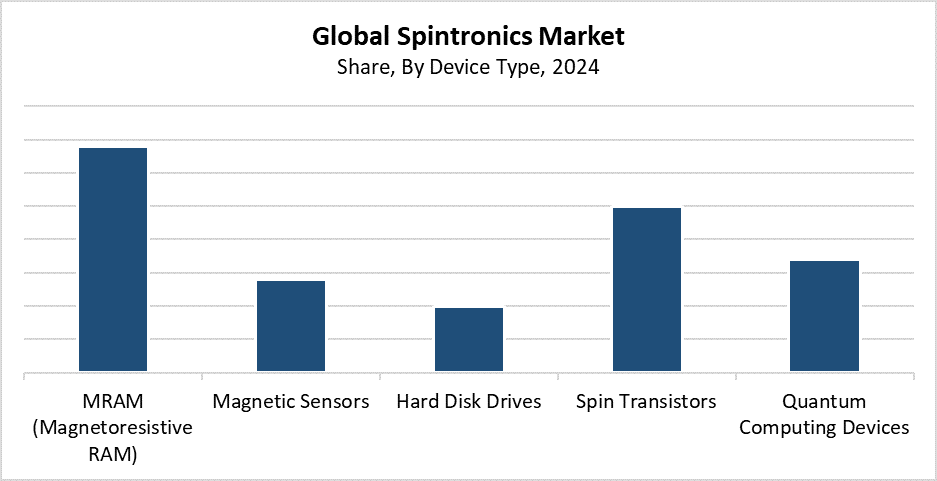Global Spintronics Market
Global Spintronics Market Size, Share, and COVID-19 Impact Analysis, By Device Type (Magnetoresistive RAM, Magnetic Sensors, Hard Disk Drives, Spin Transistors, Quantum Computing Devices), By Material (Giant Magnetoresistance (GMR), Tunnel Magnetoresistance (TMR), Others), and By Region (North America, Europe, Asia-Pacific, Latin America, Middle East, and Africa), Analysis and Forecast 2025-2035
Report Overview
Table of Contents
Spintronics Market Summary
The Global Spintronics Market Size Was Valued at USD 1714.2 Million in 2024 and is Projected to Reach USD 18674.8 Million by 2035, Growing at a CAGR of 24.25% from 2025 to 2035. The market for spintronics is growing due to the growing need for fast, energy-efficient memory devices, improvements in semiconductor technology, the growing use of MRAM, and the growing applications in the consumer electronics, automotive, data storage, and quantum computing industries.

Key Regional and Segment-Wise Insights
- In 2024, the Asia Pacific held the largest revenue share of 37.4%, dominating the global market.
- In 2024, the MRAM (Magnetoresistive RAM) segment dominated the market and had the biggest revenue share by device type, accounting for 34.5%.
- In 2024, the Tunnel Magnetoresistance (TMR) segment dominated the market and had the highest revenue share of 39.4%.
Global Market Forecast and Revenue Outlook
- 2024 Market Size: USD 1714.2 Million
- 2035 Projected Market Size: USD 18674.8 Million
- CAGR (2025-2035): 24.25%
- Asia Pacific: Largest market in 2024
The spintronics market operates within the electronics sector, which develops technology to process data using electron spin properties, magnetic characteristics, and electrical charge. The emerging technology enables manufacturers to build devices that deliver enhanced speed performance and reduced power consumption while storing data even without an electrical supply. The expanding interest in innovative memory solutions, such as Magnetoresistive Random Access Memory (MRAM), together with the requirement for accelerated, efficient data storage across various sectors, propels the market forward. The advancement of wearable technology, together with IoT devices and AI systems, drives the development of memory components that require minimal power consumption and high-speed performance in compact sizes.
The technological development of spintronics has advanced substantially because giant magnetoresistance (GMR) and tunnel magnetoresistance (TMR) have expanded the performance boundaries for logic and data storage applications. Leading technology corporations, together with research facilities, dedicate substantial resources to developing spintronics for building future semiconductors. The implementation of spintronic technologies moves forward at an accelerated pace due to government-backed programs across North America, Europe, and Asia that offer funding and partnerships and national strategies to boost quantum and nanoelectronic innovation.
Device Type Insights

The MRAM (Magnetoresistive RAM) segment dominated the spintronics market with the largest revenue share of 34.5% in 2024. MRAM stands out as a popular memory technology because it delivers non-volatility with high speed and low power consumption, and outstanding endurance characteristics. The trend of growing MRAM adoption extends to consumer electronics and industrial systems, as well as automotive electronics and aerospace applications that need trustworthy and power-efficient data storage solutions. The combination of radiation resistance and power-free data retention makes MRAM the ideal solution for applications that require high reliability. The production improvements and SoC integration of MRAM technology drive its increasing market demand. The spintronics sector leader in both innovation and revenue generation remains MRAM technology.
The spin transistors segment is anticipated to grow at a significant CAGR during the forecast period. Spin transistors operate with electron spin instead of charge function at faster speeds and consume less power while offering superior scalability compared to traditional transistors. The advantages of these devices make them ideal for upcoming electronic systems, which include fast logic circuits and low-energy computing systems, together with quantum computing. The rising need for high-performance energy-efficient computing drives researchers to develop spin-based logic devices at an increasing pace. The progress in materials science and nanofabrication techniques enables practical spin transistor applications, which drive substantial growth in the dynamic spintronics market segment.
Material Insights
The Tunnel Magnetoresistance (TMR) segment maintained its position as the leading market share holder in 2024 with 39.4% of the total spintronics market. The high magnetoresistance ratios, along with fast data read/write speeds and superior energy efficiency of TMR materials, make these components essential for modern spintronic systems. The TMR technology plays an essential role in the operation of magnetic tunnel junctions (MTJs), which find application in hard disk drives and MRAM devices. The increasing demand for high-performance non-volatile memory solutions in industrial automation, automotive, and data center applications has driven the adoption of TMR-based components. The worldwide spintronics market continues to strengthen its position through the ongoing development of TMR technology, which includes improved thin-film deposition methods and material engineering for enhanced performance and reliability.
During the forecasted period, the Giant Magnetoresistance (GMR) segment is anticipated to grow at a significant CAGR. GMR technology provides electrical resistance modifications when exposed to magnetic fields, which find extensive applications in hard disk drive read heads and magnetic sensors. The system demonstrates high sensitivity levels and reliability with minimal power requirements, which makes it ideal for applications in consumer electronics and industrial automation, along with automotive systems. The rising demand for advanced sensing technologies, mainly in smart devices and electric vehicles, stands as a primary development driver. The segment's worldwide spintronics market growth will be driven by ongoing research and development efforts that enhance GMR performance and its integration into small electronic components.
Regional Insights
The North American spintronics market held a substantial revenue share in 2024 because of its robust technological base and early adoption of advanced electronics and major research and development funding. Important market participants, including notable memory and semiconductor manufacturers, have propelled the region toward spintronics innovation leadership. The United States and Canada experience rapid growth in spintronics technology applications throughout consumer electronics and data storage systems, as well as automotive systems and defense technology. Industry growth receives a boost from both government financial support programs and digital firm partnerships with academic research institutions. High-performance energy-efficient memory solutions, including MRAM and magnetic sensors, have secured North America as a vital spintronics market within the worldwide industry.
Asia Pacific Spintronics Market Trends
The Asia Pacific region led the worldwide spintronics market with the largest revenue share of 37.4% in 2024. The region maintains its market leadership through its established semiconductor production facilities and rapid industrial development, and increasing adoption of advanced electronics in China, Japan, South Korea, and Taiwan. Consumer electronics, along with data storage and automotive applications, drive market expansion because high-performance memory technologies such as MRAM experience growing market demand. The advancement of spintronics technology receives support from extensive government funding directed toward next-generation electronic research. The Asia Pacific spintronics market leads global growth because of its major electronics manufacturers, combined with expanding AI and IoT and smart device infrastructure.
Europe Spintronics Market Trends
The European spintronics market experiences fast growth because of increasing investments in advanced electronics, together with strong research support and rising demand for energy-efficient memory technologies. The collaboration between academic institutions, research centers, and industrial participants drives nations such as Germany, France, and the United Kingdom to lead the development of spintronics. The applications of spintronics technology in data storage, industrial automation, and automotive electronics perfectly match Europe's focus on low-power and sustainable technologies. The European Union supports spintronic device research through strategic projects and funding initiatives that aim to enhance semiconductor and quantum technologies development. Through its solid technological foundation and supportive policies, Europe has emerged as a leading force in the worldwide spintronics industry.
Key Spintronics Companies:
The following are the leading companies in the spintronics market. These companies collectively hold the largest market share and dictate industry trends.
- Avalanche Technology
- Samsung Electronics
- Micron Technology, Inc.
- Everspin Technologies Inc.
- NVE Corporation
- IBM Corporation
- Intel Corporation
- Qualcomm Technologies, Inc.
- Hitachi, Ltd.
- TDK Corporation
- Others
Recent Developments
- In March 2024, Avalanche Technology has announced the launch of two new high-density STT-MRAM devices that are intended to meet the persistent, high-reliability memory requirements of space applications. These devices can be used in contemporary aerospace electronic systems because they have a smaller form factor, better performance, and lower power consumption.
- In October 2023, Everspin Technologies Inc. announced an expansion of its industrial STT-MRAM product line, a high-density, persistent memory solution. These devices' high performance, robustness, and broad temperature range make them ideal for mission-critical applications.
Market Segment
This study forecasts revenue at global, regional, and country levels from 2020 to 2035. Spherical Insights has segmented the spintronics market based on the below-mentioned segments:
Global Spintronics Market, By Device Type
- MRAM (Magnetoresistive RAM)
- Magnetic Sensors
- Hard Disk Drives
- Spin Transistors
- Quantum Computing Devices
Global Spintronics Market, By Material
- Giant Magnetoresistance (GMR)
- Tunnel Magnetoresistance (TMR)
- Others
Global Spintronics Market, By Regional Analysis
- North America
- US
- Canada
- Mexico
- Europe
- Germany
- UK
- France
- Italy
- Spain
- Russia
- Rest of Europe
- Asia Pacific
- China
- Japan
- India
- South Korea
- Australia
- Rest of Asia Pacific
- South America
- Brazil
- Argentina
- Rest of South America
- Middle East & Africa
- UAE
- Saudi Arabia
- Qatar
- South Africa
- Rest of the Middle East & Africa
Check Licence
Choose the plan that fits you best: Single User, Multi-User, or Enterprise solutions tailored for your needs.
We Have You Covered
- 24/7 Analyst Support
- Clients Across the Globe
- Tailored Insights
- Technology Tracking
- Competitive Intelligence
- Custom Research
- Syndicated Market Studies
- Market Overview
- Market Segmentation
- Growth Drivers
- Market Opportunities
- Regulatory Insights
- Innovation & Sustainability
Report Details
| Pages | 240 |
| Delivery | PDF & Excel via Email |
| Language | English |
| Release | Sep 2025 |
| Access | Download from this page |
